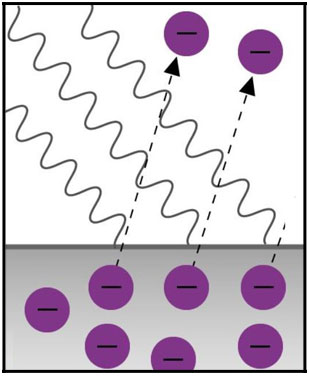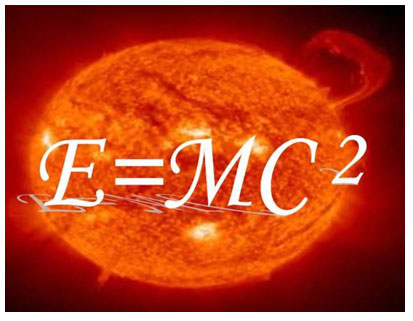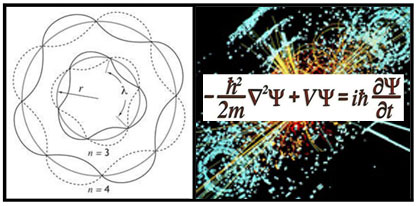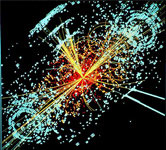A Bridge: Science to Religion “Science without religion is lame, religion without science is blind.” ― Albert Einstein “I assert that the nature of reality is spiritual, not material nor a dualism of matter and spirit.” ― Sir Arthur Eddington “It does not matter whether objects ‘exist in my mind, or that of and other created spirit’ or not; their objectivity arises from their subsisting ‘in the mind of some Eternal Spirit’" ― Bishop Berkeley “The universe begins to look more like a great thought than like a great machine. Mind no longer appears as an accidental intruder into the realm of matter; we are beginning to suspect that we ought rather to hail it as the creator and governor of the realm of matter – no, of course, our individual minds, but the mind in which the atoms out of which our individual minds have grown exist as thoughts.” ― The Mysterious Universe, Sir James Jeans New Physics – New
Truths The breakdown of Causal determinism began with the new investigations of LIGHT in the early twentieth-century. Prior to the revolutionary discoveries of light, classical physics explained light phenomena with wave theory. Light behaved as if its energy was distributed continuously throughout a wave (electromagnetic wave). Late nineteenth-century physicists were surprised to learn that the light from any heated object produced the same behavior – most of the light was given off at one particular frequency. When the temperature was raised, the peak frequency shifted to bluer (higher) frequencies, moving from red through yellow to blue-white. Classical physics predicts no such peak, but that an infinite amount of energy should be released at higher frequencies (the so-called “ultraviolet catastrophe”). Max Planck solved the issue by joining the physics of heat and electromagnetism (light). His insight was to describe light as a vast collection of electromagnetic oscillators or tiny subatomic units of electromagnetic field (temperature was viewed as the sharing of heat energy amongst a vast collection of particles). His new model (‘truth’) fitted with the peak frequency observation. Planck’s new “quantum” view of energy planted the seed for the future of modern physics: quantum theory. From 1901 to 1927 the following new discoveries and theories in physics occurred: Light’s Property: energy of emitted electrons from a light source was related to the frequency (color) of the light, not the intensity as predicted by Maxwell’s wave theory of light. Light could not be explained purely as a wave phenomenon.
Light’s
Interaction with Matter: electric currents are generated
in metals (or particles emitted) when they are illuminated by blue or ultraviolet light (photoelectric
effect). Physicists were surprised to learn that a red or green light, even a bright beam of red or
green light, failed to generate this effect. Albert Einstein created a new definition of light: light
is made of individual quantum particles. Light’s behavior is explained with quantized energy or
photons (Einstein was later
awarded the Nobel Prize in 1921). Quantum theory contradicts classical wave theory which assumes infinite
divisibility of energy. Einstein’s new model (‘truth’) of light is controversial – the dawn of the
wave-particle duality: light is both a wave and a particle. To this day physicists have failed to devise an
experiment to catch light’s true nature. If an experiment is set up to measure light’s wave properties, light
behaves as a wave. If the experiment is set up to measure light’s particle properties, light behaves as
particles.
E = mc2: Einstein accepted Maxwell’s postulate that the speed of light is a constant. His grand insight was that time and mass must change as you approached the speed of light (1905). The Space-Time concept is born. During Einstein’s time people assumed that time was like a watch on God’s hand – that it beat at a steady rate throughout the universe, no matter where you were. Einstein disagreed with classical physics. The tick, tick of the wristwatch is actually the click, click of electricity turning into magnetism, turning back into electricity – the steady pace of light itself. When you approach the speed of light the energy that’s contributing to speed gets put into mass (since c is constant). Mass gets heavier. The scientific community was very slow to respond this radical idea (‘truth’). Max Planck recognizes Einstein pioneering work and is appointed professor in Zurich University. Einstein becomes the ‘father’ of modern physics.
Matter’s Atomic Property: Louis de Broglie (1924) puts forward the idea that particles of matter behave like waves (supports the particle-wave duality). Erwin Schrodinger’s mathematics (wave equations) uses the physics of waves and probability. Classical Newtonian elements of space and time is removed from any underlying reality. Max Born proposes that sub-atomic mechanics is to be understood as a probability without any causal explanation. Werner Heisenberg’s uncertainty principle states that the speed (or momentum) and position of an atomic particle at an instant cannot be exactly known – the more precisely you measure one property, the less you know about the other. The very act of measuring a particle changes it, making precise knowledge impossible. Subatomic behavior, past or future, cannot be predicted with certainty. Casual determinism is dead. The uncertainty principle causes a major riff within the Newtonian mindset which assumed that the external world existed independently. The new view is that the ‘mapmaker’ cannot independently observe the world to make his ‘map’ (truth). Quantum mechanics shows, at an atomic level, that the deterministic view is meaningless and one can only talk about probabilities of outcomes. One can no longer talk about cause and effect but only chance. Disenchanted with physics based on probability, Einstein writes to Niels Bohr (1926), “I, at any rate, am convinced that He [God] does not throw dice.” Bohr later replies, “Einstein, stop telling God what to do!”
The 1927 fifth Solvay International Conference (Brussels, Belgium) on “Electrons and Photons” ranks as one of the greatest epochs in the development of scientific philosophy. The result of the conference produced an interpretation of quantum theory which essentially made an article of scientific faith based on physical theories. Danish physicist Niels Bohr, together with Heisenberg, Max Born and others developed a holistic view of quantum mechanics that became known as the Copenhagen interpretation. Currently, the interpretation is still the favorite among most physicists, although the many-worlds interpretation has been gaining interest. In 1927 competing views of quantum mechanics was widespread. Erwin Schrodinger championed the view that quantum behavior could be described using wave equations. At the other pole, Werner Heisenberg favored the particle nature of electromagnetic waves and matter. Niels Bohr brought a philosophical approach to bear on the new science. He took faith in the idea of “complementarity,” that the wave and the particle sides of matter and light were two faces of the same phenomenon. A practical analogy is a silhouette which appears either as a vase outline or two faces looking at each other. To Bohr it was not light that changed its character, but rather how we decided to view it. Extending the holistic view, Bohr also argued that one can never completely separate the observer from the system he or she is measuring. He thought that the entire systems’ behavior needed to be considered as one; you could not separate the particle, the measuring equipment and the observer. Bohr argued that the very word “observer” is wrong because it conjures up a picture of an external viewer separated from the world that is being watched. DeBroglie, Max von Laue, Schrodinger and Einstein believed that quantum mechanics was a statistical approximation to a deeper reality which is deterministic. The other founders of quantum mechanics believed that this problem is purely philosophical. Mathematical Pictures
It is important to understand that quantum interpretations are interpretations of scientific formalism – sets of equations and sets of observations. Equations and observations are the components of the interpretation. In regards to what the interpreted theory is “really about”, we return back to the roots of the scientific endeavor and question its epistemology (scientific method) and its ontology (domain). When the physicist “looks at” quantum reality (or relativistic reality), he is not looking at “things in themselves” (noumenon). He or she is looking at nothing but a set of highly abstract differential equations – not at “reality” itself, but at mathematical symbols of reality. In the study of modern physics, Sir James Jeans was specific: “we can never understand what events are, but must limit ourselves to describing the patterns of events in mathematical terms; no other aim is possible…the pictures which science now draws of nature (per observation fact) are mathematical pictures…They are nothing more than pictures – fictions if you like, if by fiction you mean that science is not yet in contact with ultimate reality…One may dig, one may sow, one may reap. But the final harvest will always be a sheaf of mathematical formulae”. A mathematical formula can never tell us what a thing is, but only how it behaves. Sir Arthur Eddington pointed out that both the old physics (deterministic) and the new physics (relativistic, nondeterministic, four-dimensional) deals with shadow-symbols and that the new quantum physics forced the scientists to be aware that they were dealing with shadows and illusions, not reality. Cycle of Physics Modern physics is not just physics, but abstract mathematical physics. Science based on faith rather than knowledge is exposed when mathematical physics leads to circular physics and inner contradictions and in the end self-deception. For example, the mathematics of the nature of space leads to circular behavior. In Einstein’s complex differential equations of empty space there are quantities called potentials. The point of this discussion is not to ‘stump the stars’ (the reader) with abstract concepts, but to shed light on the nature of faith and knowledge. So, “what are ‘potentials’?” Following the logic of the empty space equations, potentials are defined as quantities derived from intervals. “What are ‘intervals’?” Intervals are relations between pairs of events which can be measured with a scale (or clock). “What are ‘scales’? A scale is a graduated strip of matter. “What is ‘matter’?” Matter is defined as the embodiment of three related physical quantities: mass (or energy), momentum and stress. “What is ‘mass’, ‘momentum’ and ‘stress’?” Answering this question is one of the most far-reaching achievements of Einstein’s work. It turns out that in his formidable looking mathematics, mass, momentum and stress contains potentials. The physical mathematics of empty space loops back on itself – circular physics. Other physical definitions have the same kind of interlocking. Maxwell’s equations of light describe an electromagnetic wave: a changing electric field generates a magnetic field, ad infinitum. Not to poke fun at the wonderful and brilliant Mr. Einstein, but we can take humor in the elaborate mathematical structure as related to the poem “The House that Jack Built”: The ‘House that Albert Built’ Reality seems to concern religious beliefs much more than any others. It is curious that no one bothers to ask if there is a reality behind humor. In 'Quantum Questions', integral philosopher Ken Wilber is asked whether science can furnish an argument which ought to convince any reasonable atheist on the reality of the soul or of God. Mr. Wilber replies, “I could no more ram religious conviction into an atheist that I could ram a joke into the proverbial humorless Scotchman. The only hope of ‘converting’ the latter is that through contact with merry-minded companions he may begin to realize that he is missing something in life which is worth attaining.”
The cyclic scheme of physics does presuppose something outside the scope of its investigation. We ask, “When did it all begin?” “Did it begin with the Big Bang or simply at some incipient moment in time?” Profoundly supportive of the cycle of physics, the mystic answers: “Everything within this life or on the ‘Other Side’ makes circles. Everything is infinite, without end or without any sharp edges to it”. So Eddington’s tail-chasing kitty seems more like the Cheshire cat of Alice in Wonderland, appearing to the Queen of Hearts’ gallery with only its head and a sly grin, prompting Alice to remark, “I’ve seen a cat without a grin but never a grin without a cat”. The cat gradually disappears until nothing is left but its grin and leaves Alice to ponder a twist on the 1st law of thermodynamics: “if the grin is never created can it not be destroyed?”
A Bridge to
Religion Eddington’s position that theoretical science no longer has any major objections to spiritual realities marks a monumental turning point in science’s stance toward religion. Mr. Wilber concludes, “it seem highly unlikely it will ever be reversed, since it is logical and not empirical in nature; therefore, it, in all likelihood, marks final closure on that most nagging aspect of the age-old debate between physical sciences and religion.” Einstein famous equation, E=mc2, gave us the fantastic idea that everything is energy. Even what we see as solid matter is made of invisible energy waves. Quantum physics has proven that if we travel into the heart of the atom, we reach a level where the distinction between solid matter particles and energy waves becomes blurred. In other words, science has indicated that there might be something beyond the material universe. If science is defined as “knowledge” (not instrumentally validated knowledge) then contemplative religion becomes a form of science (eg, science of yoga, science of mediation, science of creative intelligence, Science of Mind). Physics becomes a branch of the Tree of Science: The Medium, The Mystic and The Physicist. God and the Electron Now the atheist scientist could reply, “but something like an electron is necessary to explain patterns we see in the physical world. In contrast, something like God isn’t necessary to explain the moral order of the universe.” Mr. Wright tells us that the atheist scientist has a good point, but that still doesn’t disprove the existence of God. And the believer could reply,
“biologists agree that the strictly physical system or process – whose working
can be wholly explained in material terms – can have such extraordinary characteristics that it is fair to posit
some special creative force as its source and ask about the nature of that force. Darwin inquired into the
creative force behind plants and animals, and his answer was evolution. Surely the believer is entitled to
ask the same question about evolution: Where did the amazing algorithm of natural selection come
from?” Giving credit to the scientist’s position, Mr. Wright expounds his view, “there’s a formidable argument the atheist scientist could make against the whole idea of comparing the conjecture existence of God to the conjectured existence of the electron. It’s a very pragmatic argument. Namely: Granted, we believe in the existence of the electron even though our attempts thus far to conceive of it have been imperfect at best. Still, there’s a sense in which our imperfect conceptions of the electron have worked. We manipulate physical reality on the assumption that electrons exist as we imperfectly conceive them and – voila – we get the personal computer. However crude our conceptions of the sources of material order, these conceptions have brought material progress.” Our relentless believer replies, “well, thinking about the source of the universe’s moral order [goodness] crudely has on balance brought moral progress. Or conception of God has ‘grown’ – that is, the moral compass of the gods we believe in has grown, and our moral imagination has thereby grown – as we’ve moved from hunter-gatherer societies to the brink of a unified global civilization; and, if we make it over that final threshold, we’ll have gotten closer still to moral truth in the bargain. So to quit thinking about God now would be to abandon a path that has been successful on its own terms – not a path of scientific inquiry that has brought scientific progress, but a path of moral inquiry that has brought moral progress.” The steely scientist checks the jab and throws another counter, “Can’t we pursue moral truth for the sake of moral truth? Do you really need God in order to sustain moral progress the way physicists need the electron in order to sustain scientific progress?” Some people need to think of a God who is aware of their daily struggles and offers solace of affirmation or reprimand. As Wright observes, “believers in God are interacting with the moral order as productively as possible by conceiving its source in a particular way, however imperfect that way is. Isn’t that kind of like physicists who interact with the physical order as productively as possible by conceiving of its subatomic sources in a particular way, however imperfect that way is?...The scientist manipulates reality in ways that implicitly say, ‘I think the subatomic world has a certain structure’, and then reality speaks back, providing positive or negative feedback. The scientific process – the evolution of scientific ideas – is a long dialogue with nature. As we’ve seen, the evolution of God, and the attendant evolution of our moral imagination, could be described as a long dialogue with nature, too”. Before we reach for an opinion in this drama, Wright cautions us with the astute observation, “all this is a bit too simple…some physicists’ think that electrons really don’t exist. The electron isn’t just imperfectly conceived; it’s an illusion, albeit a useful one” (see ‘Mathematical Pictures’). Maybe the most defensible view – of electrons and of God – is to place them somewhere between illusion and imperfect conception. Yes, there is a source of the patterns we attribute to the electron, and the electron as conceived is a useful enough proxy for that source that we shouldn’t denigrate it by calling it an “illusion”; still, our image of an electron is very, very different from what this source would look like were the human cognitive apparatus capable of apprehending it adroitly. So too with God: yes, there is a source of the moral order, and many people have a conception of God that is a useful proxy for that source; still that conception is very, very different from what the source of the moral order would look like were human cognition able to grasp it.” Harmony of
Science & Religion If the criticism about science and religion boils down to “science is genuine” and “religion is nonsensical”, the battle can never be resolved. The only real battle is between genuine science and bogus science, and between genuine religion and bogus religion. Where “genuine” means experientially verifiable (or refutable) and “bogus” means dogmatic, non-experiential. Where the “subjectively experienced” is falsifiable. Religious experience (as direct apprehension) passes the scientific test if it is experiential, repeatable and public. For example, the transmission of Buddha’s enlightenment over the centuries disproves the claim religious experience is private and non-communicable. We might naturally assume that one of the achievements of science would have been to restrict belief in miracle. But it does not seem to do so. The magnitude of creation is far beyond most finite minds’ wildest dreams or concepts. Integral philosopher Ken Wilber concludes, “science enhances the moral values of life because it furthers a love of truth and reverence – love of truth displaying itself in the constant endeavor to arrive at a more exact knowledge of the world of mind and matter around us, and reverence, because every advance in knowledge brings us face to face with the mystery of our own being”. Using a football analogy, the believers and non-believers are at the 50 yard line and each must recognize the two ‘Einsteinian’ goal posts: “Everything is a miracle” or “Nothing is a Miracle”. The Golden Seat takes the premise that everything seen (and unseen) is a miracle. Most importantly, that our lives on this planet is a miracle. “Why?” Because we come here to learn for ourselves and for God. “And what’s the purpose of that?” For one, to learn to be positive in a negative world. We keep learning until we reach a point of Gnosis and then we learn that we don’t need negativity anymore to keep learning. Then we stay home with our eternal parents – Mother & Father God – and our eternal love ones. We will always be learning about the ‘wild magnitude of creation’ and learning to love. As we grow so does God. z
|






